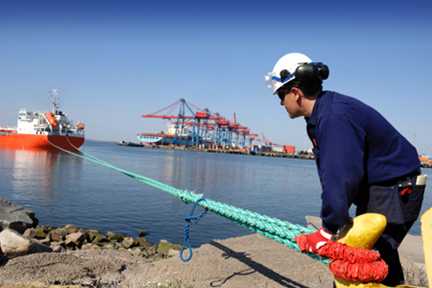Center for Maritime Safety and Health Studies

Dock worker secures mooring line to pile. Image by C. Lagereek
Program Description
Since its founding in November 2015, the Center for Maritime Safety and Health Studies has been working to identify worker populations and workplace hazards in maritime industries. This virtual center brings industry, academia, labor, and safety organizations together with researchers from across NIOSH to form partnerships to improve the safety and health of maritime workers.
The Center for Maritime Safety and Health Studies builds on the success of the NIOSH Commercial Fishing Safety Research and Design Project which has established a national surveillance program for commercial fishing fatalities in order to identify high risk fisheries and regional hazards. The Project’s activities have also focused on the prevention of vessel disasters and falls overboard, which are the leading causes of fatalities among fishermen. Research from this project has influenced regional, national, and international fishing safety policies. The success of the Commercial Fishing Safety Research and Design Project serves as a foundation for the Center for Maritime Safety and Health Studies to expand to other maritime industries.
The Center for Maritime Safety and Health Studies has identified seven maritime industries with safety and health research priorities: commercial fishing, aquaculture, seafood processing, shipyards, marine transportation, marine terminals and port operations, and commercial diving. These industries and occupations have injury and fatality rates higher than others in the U.S. They also pose unique challenges for occupational safety and health outreach, as many of these industries are made up of small businesses with few or seasonal employees, or are in remote locations. Additionally in some of these settings, employees live and work aboard the vessel.
Average Annual US Maritime Employment and Fatal/Nonfatal Injury and Illness Rates, 2011–20141
| NAICS or SOC2 | US Employment3: | US Fatality rate per 100,000 workers4: | US Nonfatal injury/illness rate per 100,000 workers5: | |
|---|---|---|---|---|
| Commercial Fishing | SOC 45-3011 | 30,885 | 105.4 | 755 |
| Aquaculture | 1125 | 6,327 | 11.9 | 5,481 |
| Seafood product preparation and packaging | 3117 | 37,380 | 3.3 | 6,289 |
| Ship and boat building | 3366 | 160,020 | 4.9 | 5,855 |
| Water transportation | 483 | 67,476 | 18.6 | 2,334 |
| Marine terminals and port operations | 4883 | 97,990 | 17.2 | 5,311 |
| Commercial Diving | SOC 49-9092 | 3,615 | 172.9 | 1,936 |
2. NAICS is the North American Industry Classification System and SOC is the Standard Occupational Classification.
3. Worker counts are based on the Bureau of Labor Statistics four year average of workers, 2011–2014. Commercial fishing counts are from the Current Population Survey, commercial diving counts are from Occupational Employment and Wages tables, and all others are from the Quarterly Census of Employment and Wages.
4. Fatality rates are based on four year averages from the Bureau of Labor Statistics Census of Fatal Occupational Injuries, 2011–2014.
5. Nonfatal injury and illness rates are based on four year averages of Bureau of Labor Statistics Survey of Occupational Injuries and Illnesses, 2011–2014.
- Page last reviewed: May 31, 2017
- Page last updated: July 18, 2017
- Content source:
Error processing SSI file


 ShareCompartir
ShareCompartir